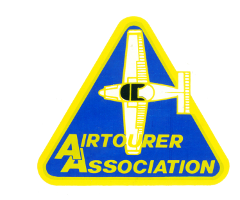Description of The Airtourer
The Airtourer is a two seat, low wing, aerobatic monoplane designed for the abinitio, aeroclub and private owner market. It was designed in the late 1950s by Henry Millicer in response to a competition run by the Royal Aero Club in the UK. (See History)
It's all metal compact design provides great strength which stood up well to the rigours of aeroclub training. The strength, in combination with the bubble canopy and light control forces made it a pleasure to fly aerobatics.
At first glance the flight controls appear unconventional with a single centre spade grip. However, once airborne, the beauty of this design becomes immediately apparent as the column falls naturally to hand with the forearm resting on the arm rest. The spade grip allows the instructor to monitor the student's inputs without interference despite there being a single column.
The single column reduces the complexity of the associated linkages, reducing free-play and friction, resulting in light control forces. Excellent roll response is achieved throughout the speed range by interlinking the flaps and ailerons. Similarly, by drooping the ailerons with flap the stall speed is reduced below 50 kts despite the short wingspan.
The Airtourer was produced with engine variants between 100 ad 150 HP. The 100HP aircraft were generally considered as underpowered in the hot Australian conditions. Later versions with 150HP and constant speed propeller proved a good combination with sufficient power to fly an aerobatic routine without excessive height loss or cruise cross-country at 120 kts. Many owner have upgraded the lower powered aircraft to 150 or 160 HP. This modification can be done under the authority of a Service Bulletin from the Airtourer Co-operative.



 Airtourer Association Inc.
Airtourer Association Inc.